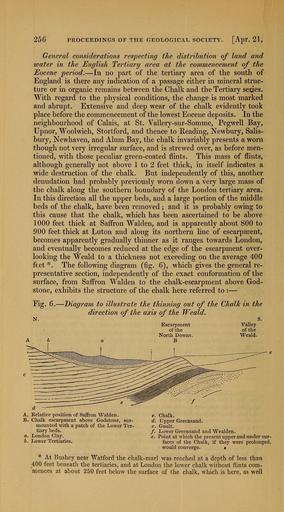MAKE A MEME
View Large Image

| View Original: | The_Quarterly_journal_of_the_Geological_Society_of_London_(12684253905).jpg (1773x3200) | |||
| Download: | Original | Medium | Small | Thumb |
| Courtesy of: | commons.wikimedia.org | More Like This | ||
| Keywords: The Quarterly journal of the Geological Society of London (12684253905).jpg 256 <br> PROCEEDINGS OF THE GEOLOGICAL SOCIETY Apr 21 <br> General considerations respecting the distribution of land and <br> water in the English Tertiary area at the commencement of the <br> Eocene period ” In no part of the tertiary area of the south of <br> England is there any indication of a passage either in mineral struc- <br> ture or in organic remains between the Chalk and the Tertiary seizes <br> With regard to the physical conditions the change is most marked <br> and abrupt Extensive and deep wear of the chalk evidently took <br> place before the commencement of the lowest Eocene deposits In the <br> neighbourhood of Calais at St Vallery-sur-Somme Pegwell Bay <br> Upnor Woolwich Stortford and thence to Reading Newbury Salis- <br> bury Newhaven and Alum Bay the chalk invariably presents a worn <br> though not very irregular surface and is strewed over as before men- <br> tioned with those peculiar green-coated flints This mass of flints <br> although generally not above 1 to 2 feet thick in itself indicates a <br> wide destruction of the chalk But independently of this another <br> denudation had probably previously worn down a very large mass of <br> the chalk along the southern boundary of the London tertiary area <br> In this direction all the upper beds and a large portion of the middle <br> beds of the chalk have been removed ; and it is probably owing to <br> this cause that the chalk which has been ascertained to be above <br> 1000 feet thick at Saffron Walden and is apparently about 800 to <br> 900 feet thick at Luton and along its northern line of escarpment <br> becomes apparently gradually thinner as it ranges towards London <br> and eventually becomes reduced at the edge of the escarpment over- <br> looking the Weald to a thickness not exceeding on the average 400 <br> feet The following diagram fig 6 which gives the general re- <br> presentative section independently of the exact conformation of the <br> surface from Saffron Walden to the chalk-escarpment above God- <br> stone exhibits the structure of the chalk here referred to ” <br> Fig 6 ” Diagram to illustrate the thinning out of the Chalk in the <br> direction of the axis of the Weald <br> A Relative position of Saffron Walden <br> B Chalk escarpment above Godstone sur- <br> mounted with a patch of the Lower Ter- <br> tiary beds <br> a London Clay <br> b Lower Tertiaries <br> e Chalk <br> d Upper Greensand <br> e Gault <br> / Lower Greensand and Wealden <br> X Point at which the present upper and under sur- <br> faces of the Chafk if they were prolonged <br> would converge « <br> At Bushey near Watford the chalk-marl was reached at a depth of less than <br> 400 feet beneath the tertiaries and at London the lower chalk without flints com- <br> mences at about 250 feet below the surface of the chalk which is here as well 35461304 109911 51125 Page 256 Text v 8 http //www biodiversitylibrary org/page/35461304 1852 Geological Society of London Biodiversity Heritage Library The Quarterly journal of the Geological Society of London v 8 1852 Geology Periodicals Smithsonian Libraries bhl page 35461304 dc identifier http //biodiversitylibrary org/page/35461304 smithsonian libraries Information field Flickr posted date ISOdate 2014-02-21 Check categories 2015 August 26 CC-BY-2 0 BioDivLibrary https //flickr com/photos/61021753 N02/12684253905 2015-08-27 12 59 05 cc-by-2 0 PD-old-70-1923 The Quarterly journal of the Geological Society of London 1852 Photos uploaded from Flickr by Fæ using a script | ||||